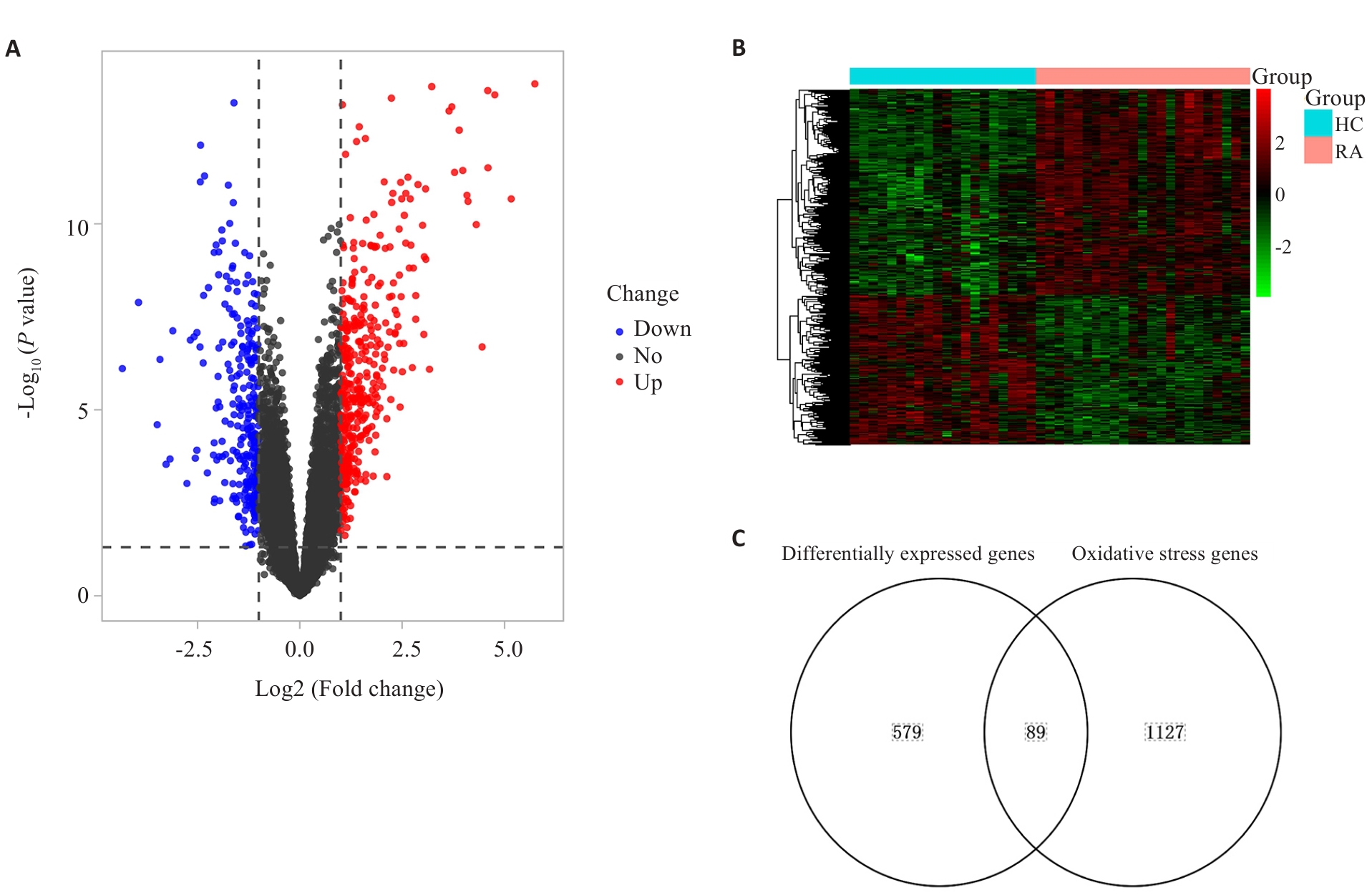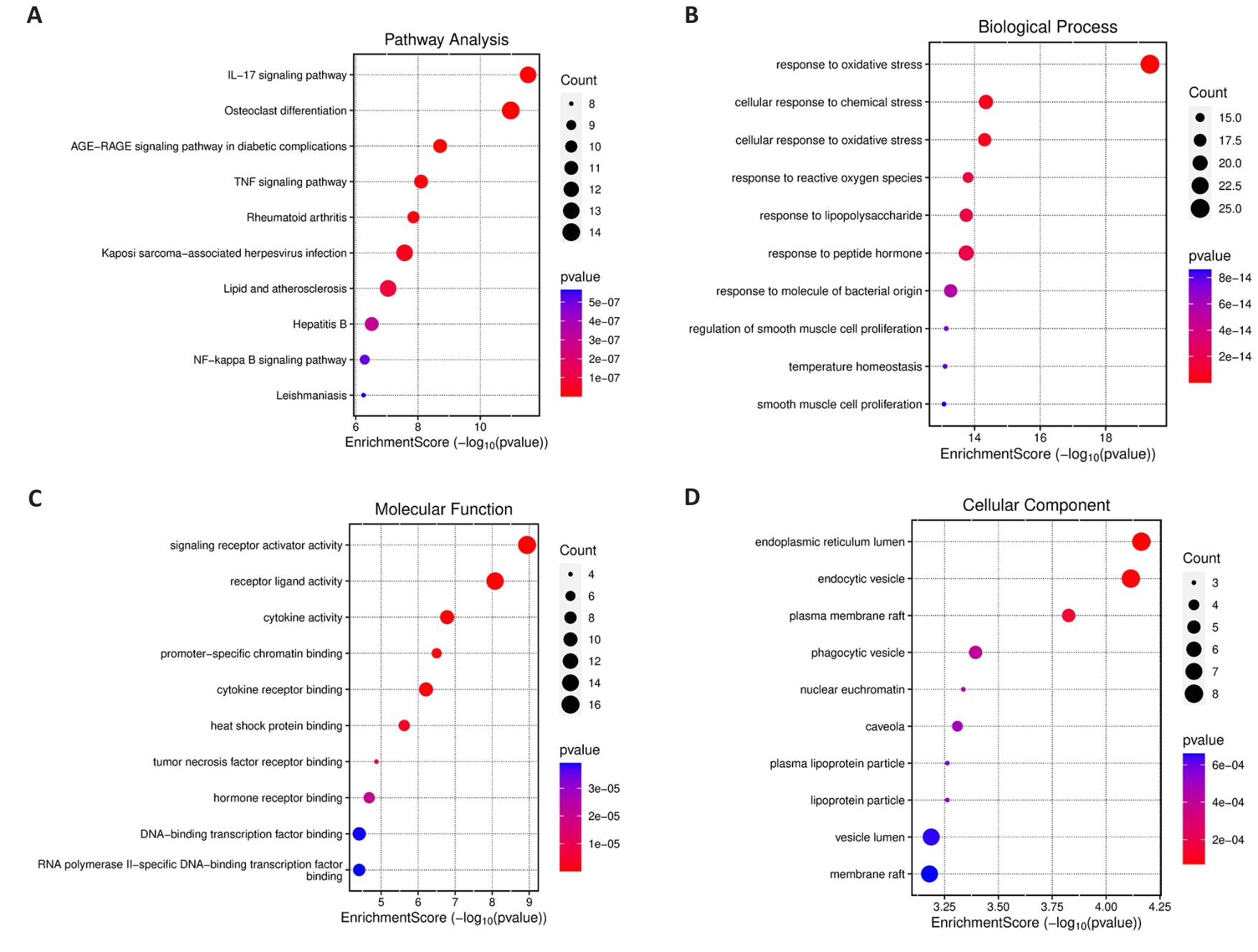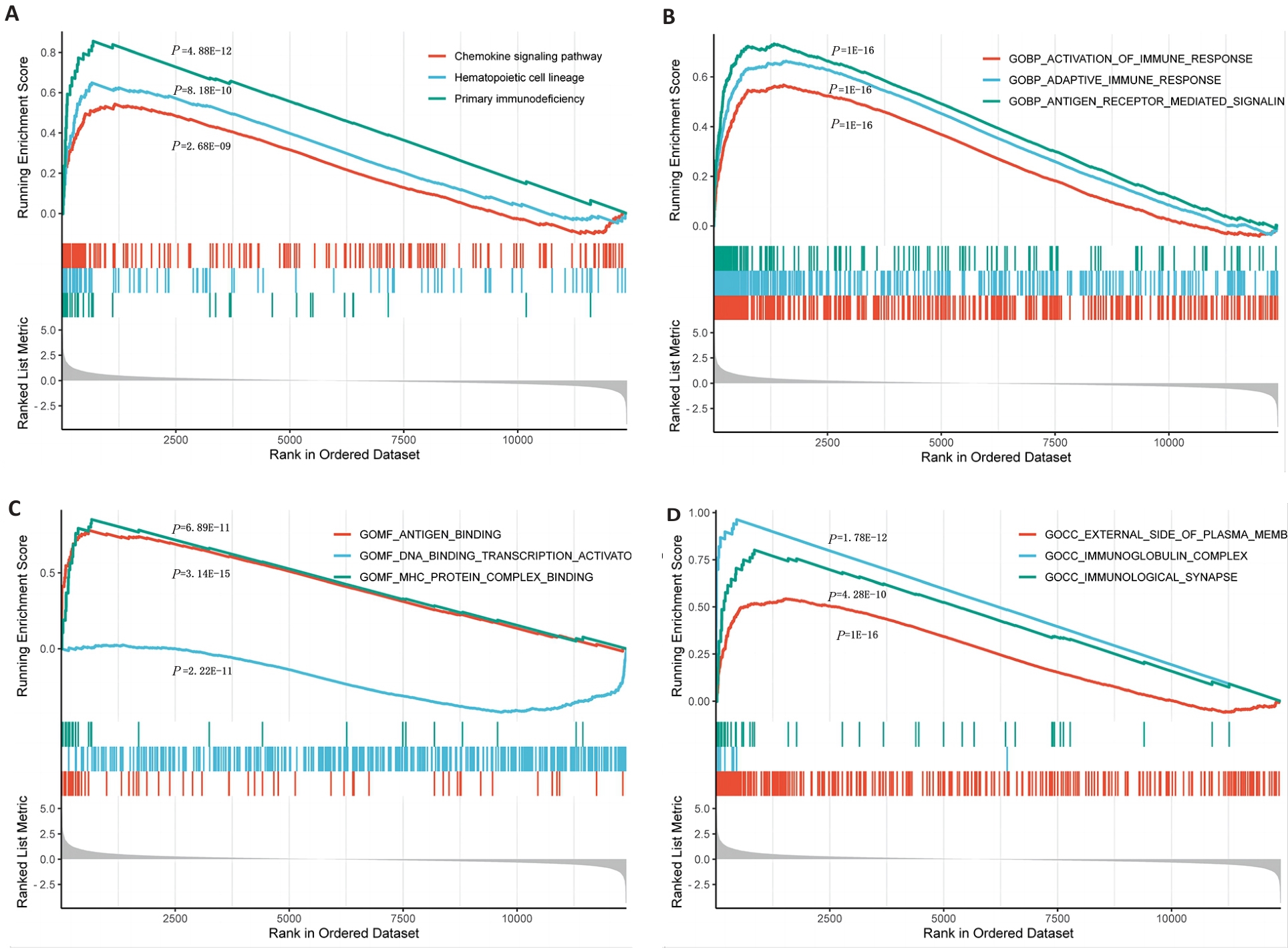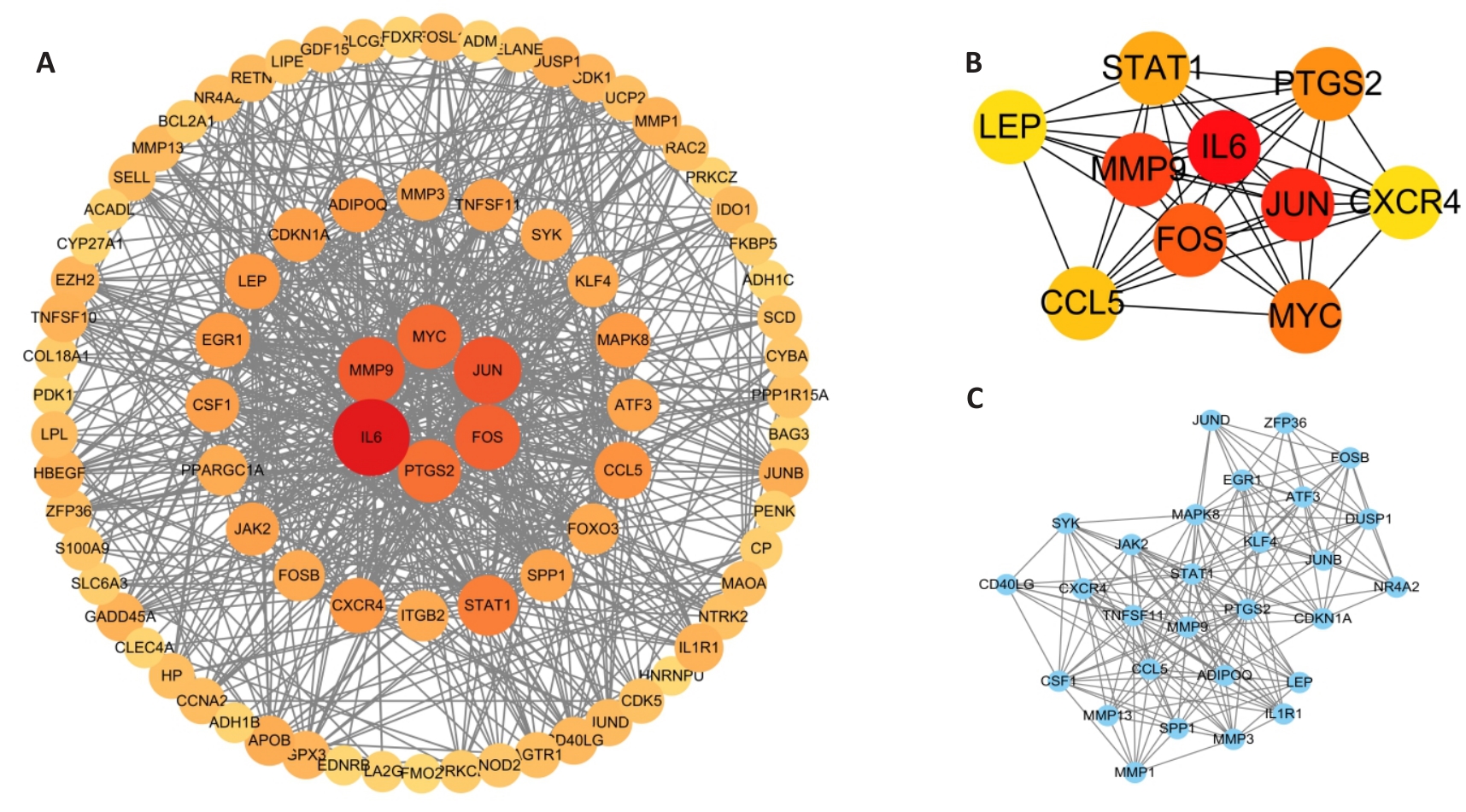Journal of Southern Medical University ›› 2025, Vol. 45 ›› Issue (4): 862-870.doi: 10.12122/j.issn.1673-4254.2025.04.22
Zhi GAO1( ), Ao WU2, Zhongxiang HU3,4, Peiyang SUN5(
), Ao WU2, Zhongxiang HU3,4, Peiyang SUN5( )
)
Received:2024-09-06
Online:2025-04-20
Published:2025-04-28
Contact:
Peiyang SUN
E-mail:gaodaren2024@163.com;1162749719@qq.com
Zhi GAO, Ao WU, Zhongxiang HU, Peiyang SUN. Bioinformatics analysis of oxidative stress and immune infiltration in rheumatoid arthritis[J]. Journal of Southern Medical University, 2025, 45(4): 862-870.
Add to citation manager EndNote|Ris|BibTeX
URL: https://www.j-smu.com/EN/10.12122/j.issn.1673-4254.2025.04.22
| Gene | Upstream primer (5'→3') | Downstream primer (5'→3') |
|---|---|---|
| JUN | GCTGAGCCTACAGATGAACT | GGCAGGATACCCAAACAAAC |
| MYC | TACACTAACATCCCACGCTC | TATAAATCATCGCAGGCGGA |
| MMP9 | TTCCAGTACCGAGAGAAAGC | CACTGCAGGATGTCATAGGT |
| STAT1 | CTGTGAAGTTGAGAGATGTGA | CAGTAACGATGAGAGGACCC |
| CCL5 | GCCCTCGCTGTCATCCTCAT | AGCACTTGCCACTGGTGTAG |
Tab.1 Primer sequences of the 5 core genes
| Gene | Upstream primer (5'→3') | Downstream primer (5'→3') |
|---|---|---|
| JUN | GCTGAGCCTACAGATGAACT | GGCAGGATACCCAAACAAAC |
| MYC | TACACTAACATCCCACGCTC | TATAAATCATCGCAGGCGGA |
| MMP9 | TTCCAGTACCGAGAGAAAGC | CACTGCAGGATGTCATAGGT |
| STAT1 | CTGTGAAGTTGAGAGATGTGA | CAGTAACGATGAGAGGACCC |
| CCL5 | GCCCTCGCTGTCATCCTCAT | AGCACTTGCCACTGGTGTAG |

Fig.1 Differentially expressed genes (DEGs) in rheumatoid arthritis (RA) and oxidative stress-associated genes. A: Volcano diagram of the DEGs in RA. B: Heat map of the DEGs (blue represents the control group, and red the disease group; on the scale bar, red represents up-regulation and green represents down-regulation. A darker color indicates a higher gene expression level). C: Wayne diagram of the DEGs and oxidative stress-related genes showing 89 intersected genes.

Fig.2 KEGG and GO enrichment analysis of DEOSGs. A: The top 10 KEGG pathway enrichment bubbles of DEOSGs. B-D: Bubble diagrams of GO enrichment results showing the top 10 biological processes, molecular functions, and cellular components.

Fig.3 GSEA enrichment analysis. A: Three KEGG pathways. B: Three GO biological processes. C: Three GO molecular functions. D: Three GO cell components.

Fig.4 Protein interaction networks of DEOSGs. A: Protein interaction network of DEOSGs. B: The top 10 key genes obtained by the Degree algorithm. C: The module with the highest MCODE score.
| 1 | Cush JJ. Rheumatoid arthritis: early diagnosis and treatment[J]. Med Clin North Am, 2021, 105(2): 355-65. |
| 2 | Shimizu Y, Ntege EH, Azuma C, et al. Management of rheumatoid arthritis: possibilities and challenges of mesenchymal stromal/stem cell-based therapies[J]. Cells, 2023, 12(14): 1905. |
| 3 | Firestein GS, McInnes IB. Immunopathogenesis of rheumatoid arthritis[J]. Immunity, 2017, 46(2): 183-96. |
| 4 | 岳进茹, 张育敏, 刘静淑, 等. 独活寄生汤含药血清细胞外囊泡对类风湿关节炎滑膜成纤维细胞的影响[J/OL]. 中国组织工程研究, 2024: 1-9. (2024-06-27). . |
| 5 | Fois AG, Paliogiannis P, Sotgia S, et al. Evaluation of oxidative stress biomarkers in idiopathic pulmonary fibrosis and therapeutic applications: a systematic review[J]. Respir Res, 2018, 19(1): 51. |
| 6 | Meng F, Lu S, Li L, et al. Different gender of oxidative balance score on the risk of rheumatoid arthritis in the US population from NHANES[J]. Int J Rheum Dis, 2024, 27(7): e15237. |
| 7 | Kardeş S, Karagülle M, Durak İ, et al. Association of oxidative stress with clinical characteristics in patients with rheumatoid arthritis[J]. Eur J Clin Investigation, 2018, 48(1): e12858. |
| 8 | Vasanthi P, Nalini G, Rajasekhar G. Status of oxidative stress in rheumatoid arthritis[J]. Int J Rheum Dis, 2009, 12(1): 29-33. |
| 9 | Kan S, Duan M, Liu Y, et al. Role of mitochondria in physiology of chondrocytes and diseases of osteoarthritis and rheumatoid arthritis[J]. Cartilage, 2021, 13(): 1102S-21S. |
| 10 | 汪敏杰, 孙大卫, 杭明辉, 等. 针刺治疗膝骨关节炎的疗效及其机制的研究进展[J]. 世界中医药, 2024, 19(13): 2011-7. |
| 11 | 闵远骞, 李 姗, 刘湘花, 等. 活性氧/活性氮与NF-κB信号通路级联交互在肝纤维化中的作用[J]. 临床肝胆病杂志, 2023, 39(6): 1454-60. |
| 12 | Benchabane S, Sour S, Zidi S, et al. Exploring the relationship between oxidative stress status and inflammatory markers during primary Sjögren's syndrome: a new approach for patient monitoring[J]. Int J Immunopathol Pharmacol, 2024, 38: 3946320241263034. |
| 13 | Mateen S, Moin S, Khan AQ, et al. Increased reactive oxygen species formation and oxidative stress in rheumatoid arthritis[J]. PLoS One, 2016, 11(4): e0152925. |
| 14 | Zhang W, Wu H, Liao Y, Zhu C, Zou Z. Caspase family in autoimmune diseases. Autoimmun Rev. 2024 Dec 3;24(2):103714. |
| 15 | 吴 傲,于 鹏, 滕加文, 等.骨关节炎的氧化应激相关基因和免疫浸润分析[J].中国组织工程研究, 2025, 29(02): 302-311. |
| 16 | Liberzon A, Birger C, Thorvaldsdóttir H, et al. The Molecular Signatures Database (MSigDB) hallmark gene set collection[J]. Cell Syst, 2015, 1(6): 417-25. |
| 17 | Gu X, Lai D, Liu S, et al. Hub genes, diagnostic model, and predicted drugs related to iron metabolism in Alzheimer's disease[J]. Front Aging Neurosci, 2022, 14: 949083. |
| 18 | Deng CF, Zhang Q, He PH, et al. Targeted apoptosis of macrophages and osteoclasts in arthritic joints is effective against advanced inflammatory arthritis[J]. Nat Commun, 2021, 12: 2174. |
| 19 | Jang S, Kwon EJ, Lee JJ. Rheumatoid arthritis: pathogenic roles of diverse immune cells[J]. Int J Mol Sci, 2022, 23(2): 905. |
| 20 | 李朝霞, 高 鲁, 张晓峰, 等.铁死亡在类风湿性关节炎中的研究进展[J].中国骨质疏松杂志, 2024, 30(06): 889-94. |
| 21 | Hirvonen H, Kautiainen H, Moilanen E, et al. The effect of cryotherapy on total antioxidative capacity in patients with active seropositive rheumatoid arthritis[J]. Rheumatol Int, 2017, 37(9): 1481-7. |
| 22 | 赵 磊, 万 磊, 刘 健, 等. 新风胶囊通过调节Notch1通路、巨噬细胞极化改善类风湿关节炎大鼠关节炎症[J]. 中医学报, 2023, 38(1): 120-6. |
| 23 | Miossec P, Kolls JK. Targeting IL-17 and TH17 cells in chronic inflammation[J]. Nat Rev Drug Discov, 2012, 11: 763-76. |
| 24 | 杨娟娟, 李浩林, 杨天宁, 等. 祖师麻膏药对胶原诱导型关节炎小鼠炎症及骨破坏的抑制作用[J]. 中国临床药理学与治疗学, 2024, 29(9): 979-87. |
| 25 | Honorati MC, Neri S, Cattini L, et al. Interleukin-17, a regulator of angiogenic factor release by synovial fibroblasts[J]. Osteoarthr Cartil, 2006, 14(4): 345-52. |
| 26 | Xin R, Xu Y, Long D, et al. Mitochonic acid-5 inhibits reactive oxygen species production and improves human chondrocyte survival by upregulating SIRT3-mediated, parkin-dependent mitophagy[J]. Front Pharmacol, 2022, 13: 911716. |
| 27 | Chabaud M, Garnero P, Dayer JM, et al. Contribution of interleukin 17 to synovium matrix destruction in rheumatoid arthritis[J]. Cytokine, 2000, 12(7): 1092-9. |
| 28 | 刘 琴, 魏建波. ROC曲线评价MMP-2和MMP-9在类风湿关节炎诊断中的价值[J]. 中国卫生检验杂志, 2014, 24(4): 531-3. |
| 29 | Zou J, Li XL, Shi ZM, et al. Effects of C-myc gene silencing on interleukin-1β-induced rat chondrocyte cell proliferation, apoptosis and cytokine expression[J]. J Bone Miner Metab, 2018, 36(3): 286-96. |
| 30 | 胡 伟, 荣 超, 陈飞虎, 等. 基质金属蛋白酶在类风湿关节炎发病机制中的作用研究进展[J]. 安徽医学, 2011, 32(5): 671-3. |
| 31 | Van Raemdonck K, Umar S, Palasiewicz K, et al. Interleukin-34 reprograms glycolytic and osteoclastic rheumatoid arthritis macrophages via syndecan 1 and macrophage colony-stimulating factor receptor[J]. Arthritis Rheumatol, 2021, 73(11): 2003-14. |
| 32 | Wu A, Yang ZK, Kong P, et al. Exploring osteosarcoma based on the tumor microenvironment[J]. Front Immunol. 2024 11(15): 1423194. |
| 33 | Sakuraba K, Krishnamurthy A, Sun JT, et al. Autoantibodies targeting malondialdehyde-modifications in rheumatoid arthritis regulate osteoclasts via inducing glycolysis and lipid biosynthesis[J]. J Autoimmun, 2022, 133: 102903. |
| 34 | Yoshida S, Arakawa F, Higuchi F, et al. Gene expression analysis of rheumatoid arthritis synovial lining regions by cDNA microarray combined with laser microdissection: up-regulation of inflammation-associated STAT1 IRF1 CXCL9 CXCL10 and CCL5[J]. Scand J Rheumatol, 2012, 41(3): 170-9. |
| 35 | Lu H, Hou G, Zhang Y, et al. C-Jun transactivates Puma gene expression to promote osteoarthritis[J]. Mol Med Rep, 2014, 9(5): 1606-12. |
| 36 | Ye Z, Chen Y, Zhang R, et al. C-Jun N-terminal kinase-c-Jun pathway transactivates Bim to promote osteoarthritis[J]. Can J Physiol Pharmacol, 2014, 92(2): 132-9. |
| 37 | Bleck D, Loacker-Schöch K, Classen T, et al. Fibroblast-like synoviocytes preferentially induce terminal differentiation of IgD+ memory B cells instead of naïve B cells[J]. Immunology, 2024, 173(3): 520-35. |
| 38 | Floudas A, Neto N, Marzaioli V, et al. Pathogenic, glycolytic PD-1+ B cells accumulate in the hypoxic RA joint[J]. JCI Insight, 2020, 5(21): 139032. |
| 39 | Álvarez K, Palacio J, Agudelo NA, et al. B cell-targeted polylactic acid nanoparticles as platform for encapsulating jakinibs: potential therapeutic strategy for systemic lupus erythematosus[J]. Nanomedicine, 2023, 18(27): 2001-19. |
| 40 | Wu F, Gao J, Kang J, et al. B cells in rheumatoid arthritis: pathogenic mechanisms and treatment prospects[J]. Front Immunol, 2021, 12: 750753. |
| [1] | Pengwei HUANG, Jie CHEN, Jinhu ZOU, Xuefeng GAO, Hong CAO. Quercetin mitigates HIV-1 gp120-induced rat astrocyte neurotoxicity via promoting G3BP1 disassembly in stress granules [J]. Journal of Southern Medical University, 2025, 45(2): 304-312. |
| [2] | Zhoufang CAO, Yuan WANG, Mengna WANG, Yue SUN, Feifei LIU. LINC00837/miR-671-5p/SERPINE2 functional axis promotes pathological processes of fibroblast-like synovial cells in rheumatoid arthritis [J]. Journal of Southern Medical University, 2025, 45(2): 371-378. |
| [3] | Huaiwen XU, Li WENG, Hong XUE. CXCL12 is a potential therapeutic target for type 2 diabetes mellitus complicated by chronic obstructive pulmonary disease [J]. Journal of Southern Medical University, 2025, 45(1): 100-109. |
| [4] | Yaobin WANG, Liuyan CHEN, Yiling LUO, Jiqing SHEN, Sufang ZHOU. Predictive value of NUF2 for prognosis and immunotherapy responses in pan-cancer [J]. Journal of Southern Medical University, 2025, 45(1): 137-149. |
| [5] | Junping ZHAN, Shuo HUANG, Qingliang MENG, Wei FAN, Huimin GU, Jiakang CUI, Huilian WANG. Buyang Huanwu Decoction reduces mitochondrial autophagy in rheumatoid arthritis synovial fibroblasts in hypoxic culture by inhibiting the BNIP3-PI3K/Akt pathway [J]. Journal of Southern Medical University, 2025, 45(1): 35-42. |
| [6] | Mengnan YE, Hongmei WU, Yan MEI, Qingling ZHANG. High expression of CREM is associated with poor prognosis in gastric cancer patients [J]. Journal of Southern Medical University, 2024, 44(9): 1776-1782. |
| [7] | Rui YANG, Yuqin SHU, Huijie WEN, Xi CAI, Zhen WANG, Chen ZHANG, Yang XIANG, Hao WU. Pterocarya hupehensis Skan total flavones ameliorate rheumatoid arthritis in rats by suppressing formation of neutrophil extracellular traps [J]. Journal of Southern Medical University, 2024, 44(9): 1645-1652. |
| [8] | Kai JI, Guanyu YU, Leqi ZHOU, Tianshuai ZHANG, Qianlong LING, Wenjiang MAN, Bing ZHU, Wei ZHANG. HNRNPA1 gene is highly expressed in colorectal cancer: its prognostic implications and potential as a therapeutic target [J]. Journal of Southern Medical University, 2024, 44(9): 1685-1695. |
| [9] | Yuming ZHANG, Shicheng XIA, Linlin ZHANG, Mengxi CHEN, Xiaojing LIU, Qin GAO, Hongwei YE. Protective effect of Lonicerae japonicae flos extract against doxorubicin-induced liver injury in mice [J]. Journal of Southern Medical University, 2024, 44(8): 1571-1581. |
| [10] | Shan XIANG, Zongxing ZHANG, Lu JIANG, Daozhong LIU, Weiyi LI, Zhuoma BAO, Rui TIAN, Dan CHENG, Lin YUAN. Tujia medicine Toddalia asiatica improves synovial pannus in rats with collagen-induced arthritis through the PI3K/Akt signaling pathway [J]. Journal of Southern Medical University, 2024, 44(8): 1582-1588. |
| [11] | Hongli YANG, Yayun XIANG, Tingting TAN, Yang LEI. ORY-1001 inhibits glioblastoma cell growth by downregulating the Notch/HES1 pathway via suppressing lysine-specific demethylase 1 expression [J]. Journal of Southern Medical University, 2024, 44(8): 1620-1630. |
| [12] | Zhijun REN, Jianxin DIAO, Yiting WANG. Xionggui Decoction alleviates heart failure in mice with myocardial infarction by inhibiting oxidative stress-induced cardiomyocyte apoptosis [J]. Journal of Southern Medical University, 2024, 44(7): 1416-1424. |
| [13] | Lili CHEN, Tianyu WU, Ming ZHANG, Zixia DING, Yan ZHANG, Yiqing YANG, Jiaqian ZHENG, Xiaonan ZHANG. Identification of potential biomarkers and immunoregulatory mechanisms of rheumatoid arthritis based on multichip co-analysis of GEO database [J]. Journal of Southern Medical University, 2024, 44(6): 1098-1108. |
| [14] | Guoxin LIANG, Hongyue TANG, Chang GUO, Mingming ZHANG. MiR-224-5p overexpression inhibits oxidative stress by regulating the PI3K/Akt/FoxO1 axis to attenuate hypoxia/reoxygenation-induced cardiomyocyte injury [J]. Journal of Southern Medical University, 2024, 44(6): 1173-1181. |
| [15] | Wei ZHOU, Jun NIE, Jia HU, Yizhi JIANG, Dafa ZHANG. Differential expressions of endoplasmic reticulum stress-associated genes in aortic dissection and their correlation with immune cell infiltration [J]. Journal of Southern Medical University, 2024, 44(5): 859-866. |
| Viewed | ||||||
|
Full text |
|
|||||
|
Abstract |
|
|||||